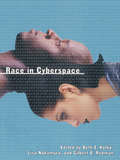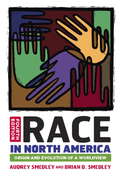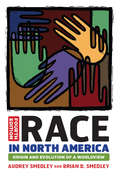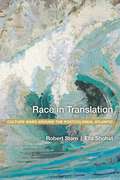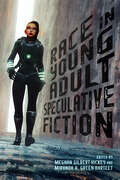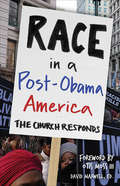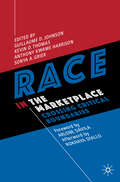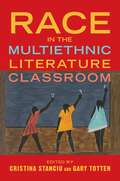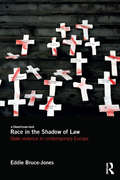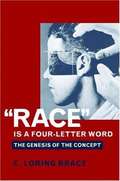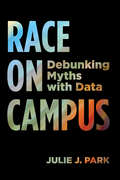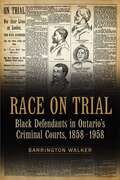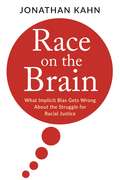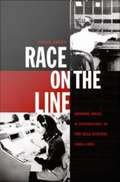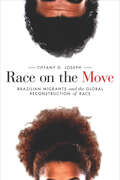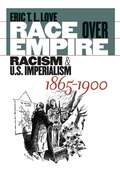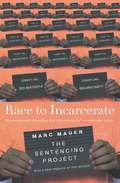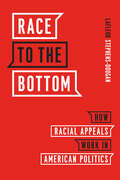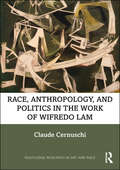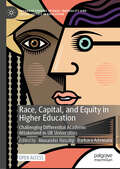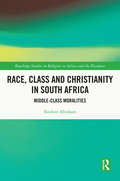- Table View
- List View
Race in Cyberspace
by Lisa Nakamura Beth E. Kolko Gisbert B. RodmanGroundbreaking and timely, Race in Cyberspace brings to light the important yet vastly overlooked intersection of race and cyberspace.
Race in North America
by Audrey Smedley Brian SmedleySmedley's (anthropology and african american studies, Virginia Commonwealth U. ) study of the history of race takes as a central premise that race is a sociocultural phenomenon, and one peculiar to only some cultures, rather than a biologically coherent concept. She maintains that races are real as cultural creations though, with very material consequences. She focuses on the United States, where she thinks race has seen the most thorough institutionalization outside of South Africa, and the history of the inheritance of the concept from the English. She covers race ideology in science, which she argues is where many American beliefs about race came from in the 19th and earlier 20th centuries. Much of the study is a history of science and query into the relationship between science and social thought. This fourth edition contains new material about racial slavery and the preference for Africans in America, though less in the sections on various histories. She also offers a new section on race in light of Barack Obama. Her son, Brian Smedley (health policy, Joint Center for Political and Economic Studies) authors the final chapter on racial discrimination in medicine and alternatives to the racial-herditarian paradigm. Annotation ©2011 Book News, Inc. , Portland, OR (booknews. com)
Race in North America
by Audrey Smedley Brian SmedleyThis sweeping work traces the idea of race for more than three centuries to show that "race” is not a product of science but a cultural invention that has been used variously and opportunistically since the eighteenth century. Updated throughout, the fourth edition of this renowned text includes a compelling new chapter on the health impacts of the racial worldview, as well as a thoroughly rewritten chapter that explores the election of Barack Obama and its implications for the meaning of race in America and the future of our racial ideology.
Race in North America
by Brian D. Smedley Audrey SmedleyIn Race in North America, Audrey Smedley shows that "race" is a cultural invention that has been used variously and opportunistically since the eighteenth century. Race, in its origin, was not a product of science but of a folk ideology reflecting a new form of social stratification and a rationalization for inequality among the peoples of North America.New coauthor Brian Smedley joins Audrey Smedley in updating this renowned and groundbreaking text. The fourth edition includes a compelling new chapter on the health impacts of the racial worldview, as well as a thoroughly rewritten chapter that explores the election of Barack Obama and the evolving role of race in American political history. This edition also incorporates recent findings on the human genome and the implications of genomics. Drawing on new understandings of DNA expression, the authors scrutinize the positions of contemporary race scientists who maintain that race is a valid biological concept.
Race in North America: Origin and Evolution of a Worldview
by Audrey SmedleyThis sweeping work traces the idea of race for more than three centuries to show that ?race? is not a product of science but a cultural invention that has been used variously and opportunistically since the eighteenth century. Updated throughout, the fourth edition of this renowned text includes a compelling new chapter on the health impacts of the racial worldview, as well as a thoroughly rewritten chapter that explores the election of Barack Obama and its implications for the meaning of race in America and the future of our racial ideology.
Race in Translation: Culture Wars around the Postcolonial Atlantic
by Ella Shohat Robert StamWhile the term “culture wars” often designates the heated arguments inthe English-speaking world spiraling around race, the canon, and affirmativeaction, in fact these discussions have raged in diverse sites and languages. Racein Translation charts thetransatlantic traffic of the debates within and between three zones—the U.S.,France, and Brazil. Stam and Shohat trace the literal and figurative translation of thesemultidirectional intellectual debates, seen most recently in the emergence ofpostcolonial studies in France, and whiteness studies in Brazil. The authorsalso interrogate an ironic convergence whereby rightist politicians likeSarkozy and Cameron join hands with some leftist intellectuals like BennMichaels, Žižek, and Bourdieu in condemning “multiculturalism” and “identitypolitics.” At once a report from various “fronts” in the culture wars, amapping of the germane literatures, and an argument about methods of readingthe cross-border movement of ideas, the book constitutes a major contribution toour understanding of the Diasporic and the Transnational.
Race in Young Adult Speculative Fiction (Children's Literature Association Series)
by Meghan Gilbert-Hickey and Miranda A. Green-BarteetWinner of the Children’s Literature Association’s 2023 Edited Book AwardContributions by Malin Alkestrand, Joshua Yu Burnett, Sean P. Connors, Jill Coste, Meghan Gilbert-Hickey, Miranda A. Green-Barteet, Sierra Hale, Kathryn Strong Hansen, Elizabeth Ho, Esther L. Jones, Sarah Olutola, Alex Polish, Zara Rix, Susan Tan, and Roberta Seelinger TritesRace in Young Adult Speculative Fiction offers a sustained analysis of race and representation in young adult speculative fiction (YASF). The collection considers how characters of color are represented in YASF, how they contribute to and participate in speculative worlds, how race affects or influences the structures of speculative worlds, and how race and racial ideologies are implicated in YASF. This collection also examines how race and racism are discussed in YASF or if, indeed, race and racism are discussed at all. Essays explore such notable and popular works as the Divergent series, The Red Queen, The Lunar Chronicles, and the Infernal Devices trilogy. They consider the effects of colorblind ideology and postracialism on YASF, a genre that is often seen as progressive in its representation of adolescent protagonists. Simply put, colorblindness silences those who believe—and whose experiences demonstrate—that race and racism do continue to matter. In examining how some YASF texts normalize many of our social structures and hierarchies, this collection examines how race and racism are represented in the genre and considers how hierarchies of race are reinscribed in some texts and transgressed in others.Contributors point toward the potential of YASF to address and interrogate racial inequities in the contemporary West and beyond. They critique texts that fall short of this possibility, and they articulate ways in which readers and critics alike might nonetheless locate diversity within narratives. This is a collection troubled by the lingering emphasis on colorblindness in YASF, but it is also the work of scholars who love the genre and celebrate its progress toward inclusivity, and who further see in it an enduring future for intersectional identity.
Race in a Post-Obama America: The Church Responds
by David Maxwell EditorRecent events in the United States have provoked not just a willingness to discuss issues of racism in this country but a desire to do something meaningful to confront it. Race in a Post-Obama America offers concerned Christians the chance to clarify terms and issues around racism and discern how to respond. <P><P>The reader will learn the basic definitions and history around racism in the United States, be presented with current thoughts on institutional racism and what is to be done to end it, and learn about specific actions individuals and churches are taking. Designed for individual or group study, the book includes questions for reflection and discussion.
Race in the Marketplace: Crossing Critical Boundaries
by Guillaume D. Johnson Kevin D. Thomas Anthony Kwame Harrison Sonya A. GrierThis volume offers a critical, cross-disciplinary, and international overview of emerging scholarship addressing the dynamic relationship between race and markets. Chapters are engaging and accessible, with timely and thought-provoking insights that different audiences can engage with and learn from. Each chapter provides a unique journey into a specific marketplace setting and its sociopolitical particularities including, among others, corner stores in the United States, whitening cream in Nigeria and India, video blogs in Great Britain, and hospitals in France. By providing a cohesive collection of cutting-edge work, Race in the Marketplace contributes to the creation of a robust stream of research that directly informs critical scholarship, business practices, activism, and public policy in promoting racial equity.
Race in the Multiethnic Literature Classroom
by Martha J. Cutter C. A. Snyder Joanne Lipson Freed Sarah Minslow Luis Cortés Jennifer Ann Ho Yadira Gamez Lauren J. Gantz Crystal R. Perez Kristen Brown Norell Martinez Emily R. Rutter Ariel Santos Kevin Pyon Shermaine M. Jones Marilyn Edelstein Nancy H. Carranza Naomi EdwardsThe contemporary rethinking and relearning of history and racism has sparked creative approaches for teaching the histories and representations of marginalized communities. Cristina Stanciu and Gary Totten edit a collection that illuminates these ideas for a variety of fields, areas of education, and institutional contexts. The authors draw on their own racial and ethnic backgrounds to examine race and racism in the context of addressing necessary and often difficult classroom conversations about race, histories of exclusion, and racism. Case studies, reflections, and personal experiences provide guidance for addressing race and racism in the classroom. In-depth analysis looks at attacks on teaching Critical Race Theory and other practices for studying marginalized histories and voices. Throughout, the contributors shine a light on how a critical framework focused on race advances an understanding of contemporary and historical US multiethnic literatures for students around the world and in all fields of study. Contributors: Kristen Brown, Nancy Carranza, Luis Cortes, Marilyn Edelstein, Naomi Edwards, Joanne Lipson Freed, Yadira Gamez, Lauren J. Gantz, Jennifer Ho, Shermaine M. Jones, Norell Martinez, Sarah Minslow, Crystal R. Pérez, Kevin Pyon, Emily Ruth Rutter, Ariel Santos, and C. Anneke Snyder
Race in the Shadow of Law: State Violence in Contemporary Europe
by Eddie Bruce-JonesRace in the Shadow of Law offers a critical legal analysis of European responses to institutional racism. It draws connections between contemporary legal knowledge practices and colonial systems of thought, arguing that many people of colour experience the law as a part of a racial problem, rather than a solution, to racial injustice. Based on a critical legal ethnography of anti-racism work in Europe, and with an emphasis on the German context, the book positions Black and anti-racist perspectives at the centre, rather than the margins, of critically thinking through the intersection of race and law. Combining this ethnography with comparative legal analysis, discourse analysis and critical race theory, the book develops a critical discussion of the European legal frameworks aimed at regulating racism, and particularly institutional racism, in policy and policing. In linking this critique to the transformative potential of social movements, however, it goes on to examine the strategic and creative possibility of disrupting conventional modes of engaging, and resisting, law.
Race is a Four-Letter Word
by C. Loring BraceThis book describes the concept of race as it developed from ancient times to the Holocaust and beyond.
Race on Campus: Debunking Myths with Data
by Julie J. Park2020 Critics' Choice Book Award, American Educational Studies Association (AESA) In Race on Campus, Julie J. Park argues that there are surprisingly pervasive and stubborn myths about diversity on college and university campuses, and that these myths obscure the notable significance and admirable effects that diversity has had on campus life. Based on her analysis of extensive research and data about contemporary students and campuses, Park counters these myths and explores their problematic origins. Among the major myths that she addresses are charges of pervasive self-segregation, arguments that affirmative action in college admissions has run its course and become counterproductive, related arguments that Asian Americans are poorly served by affirmative action policies, and suggestions that programs and policies meant to promote diversity have failed to address class-based disadvantages. In the course of responding to these myths, Park presents a far more positive and nuanced portrait of diversity and its place on American college campuses. At a time when diversity has become a central theme and goal of colleges and universities throughout the United States, Race on Campus offers a contemporary, research-based exploration of racial dynamics on today&’s college campuses.
Race on Trial
by Barrington WalkerWhile slavery in Canada was abolished in 1834, discrimination remained. Race on Trial contrasts formal legal equality with pervasive patterns of social, legal, and attitudinal inequality in Ontario by documenting the history of black Ontarians who appeared before the criminal courts from the mid-nineteenth to the mid-twentieth centuries.Using capital case files and the assize records for Kent and Essex counties, areas that had significant black populations because they were termini for the Underground Railroad, Barrington Walker investigates the limits of freedom for Ontario's African Canadians. Through court transcripts, depositions, jail records, Judge's Bench Books, newspapers, and government correspondence, Walker identifies trends in charges and convictions in the Black population. This exploration of the complex and often contradictory web of racial attitudes and the values of white legal elites not only exposes how blackness was articulated in Canadian law but also offers a rare glimpse of black life as experienced in Canada's past.
Race on the Brain: What Implicit Bias Gets Wrong About the Struggle for Racial Justice
by Jonathan KahnOf the many obstacles to racial justice in America, none has received more recent attention than the one that lurks in our subconscious. As social movements and policing scandals have shown how far from being “postracial” we are, the concept of implicit bias has taken center stage in the national conversation about race. Millions of Americans have taken online tests purporting to show the deep, invisible roots of their own prejudice. A recent Oxford study that claims to have found a drug that reduces implicit bias is only the starkest example of a pervasive trend. But what do we risk when we seek the simplicity of a technological diagnosis—and solution—for racism? What do we miss when we locate racism in our biology and our brains rather than in our history and our social practices?In Race on the Brain, Jonathan Kahn argues that implicit bias has grown into a master narrative of race relations—one with profound, if unintended, negative consequences for law, science, and society. He emphasizes its limitations, arguing that while useful as a tool to understand particular types of behavior, it is only one among several tools available to policy makers. An uncritical embrace of implicit bias, to the exclusion of power relations and structural racism, undermines wider civic responsibility for addressing the problem by turning it over to experts. Technological interventions, including many tests for implicit bias, are premised on a color-blind ideal and run the risk of erasing history, denying present reality, and obscuring accountability. Kahn recognizes the significance of implicit social cognition but cautions against seeing it as a panacea for addressing America’s longstanding racial problems. A bracing corrective to what has become a common-sense understanding of the power of prejudice, Race on the Brain challenges us all to engage more thoughtfully and more democratically in the difficult task of promoting racial justice.
Race on the Line: Gender, Race, & Technology in the Bell System, 1880-1980
by Venus GreenRace on the Line is the first book to address the convergence of race, gender, and technology in the telephone industry. Venus Green--a former Bell System employee and current labor historian--presents a hundred year history of telephone operators and their work processes, from the invention of the telephone in 1876 to the period immediately before the break-up of the American Telephone and Telegraph Company in 1984. Green shows how, as technology changed from a manual process to a computerized one, sexual and racial stereotypes enabled management to manipulate both the workers and the workplace. More than a simple story of the impact of technology, Race on the Line combines oral history, personal experience, and archival research to weave a complicated history of how skill is constructed and how its meanings change within a rapidly expanding industry. Green discusses how women faced an environment where male union leaders displayed economic as well as gender biases and where racism served as a persistent system of division. Separated into chronological sections, the study moves from the early years when the Bell company gave both male and female workers opportunities to advance; to the era of the "white lady" image of the company, when African American women were excluded from the industry and feminist working-class consciousness among white women was consequently inhibited; to the computer era, a time when black women had waged a successful struggle to integrate the telephone operating system but faced technological displacement and unrewarding work. An important study of working-class American women during the twentieth century, this book will appeal to a wide audience, particularly students and scholars with interest in women's history, labor history, African American history, the history of technology, and business history.
Race on the Move: Brazilian Migrants and the Global Reconstruction of Race
by Tiffany D. JosephRace on the Move takes readers on a journey from Brazil to the United States and back again to consider how migration between the two countries is changing Brazilians' understanding of race relations. Brazil once earned a global reputation as a racial paradise, and the United States is infamous for its overt social exclusion of nonwhites. Yet, given the growing Latino and multiracial populations in the United States, the use of quotas to address racial inequality in Brazil, and the flows of people between each country, contemporary race relations in each place are starting to resemble each other. Tiffany Joseph interviewed residents of Governador Valadares, Brazil's largest immigrant-sending city to the U. S. , to ask how their immigrant experiences have transformed local racial understandings. Joseph identifies and examines a phenomenon-the transnational racial optic-through which migrants develop and ascribe social meaning to race in one country, incorporating conceptions of race from another. Analyzing the bi-directional exchange of racial ideals through the experiences of migrants, Race on the Move offers an innovative framework for understanding how race can be remade in immigrant-sending communities.
Race over Empire
by Eric T. LoveGenerations of historians have maintained that in the last decade of the nineteenth century white-supremacist racial ideologies such as Anglo-Saxonism, social Darwinism, benevolent assimilation, and the concept of the "white man's burden" drove American imperialist ventures in the nonwhite world. In Race over Empire, Eric T. L. Love contests this view and argues that racism had nearly the opposite effect. From President Grant's attempt to acquire the Dominican Republic in 1870 to the annexations of Hawaii and the Philippines in 1898, Love demonstrates that the imperialists' relationship with the racist ideologies of the era was antagonistic, not harmonious. In a period marked by Jim Crow, lynching, Chinese exclusion, and immigration restriction, Love argues, no pragmatic politician wanted to place nonwhites at the center of an already controversial project by invoking the concept of the "white man's burden." Furthermore, convictions that defined "whiteness" raised great obstacles to imperialist ambitions, particularly when expansionists entered the tropical zone. In lands thought to be too hot for "white blood," white Americans could never be the main beneficiaries of empire.What emerges from Love's analysis is a critical reinterpretation of the complex interactions between politics, race, labor, immigration, and foreign relations at the dawn of the American century.
Race to Incarcerate
by Marc MauerIn this revised edition of his seminal book on race, class, and the criminal justice system, Marc Mauer, executive director of one of the United States' leading criminal justice reform organizations, offers the most up-to-date look available at three decades of prison expansion in America.Including newly written material on recent developments under the Bush administration and updated statistics, graphs, and charts throughout, the book tells the tragic story of runaway growth in the number of prisons and jails and the overreliance on imprisonment to stem problems of economic and social development. Called "sober and nuanced" by Publishers Weekly, Race to Incarcerate documents the enormous financial and human toll of the "get tough" movement, and argues for more humane-and productive-alternatives.
Race to the Bottom: How Racial Appeals Work in American Politics (Chicago Studies in American Politics)
by LaFleur Stephens-DouganAfrican American voters are a key demographic to the modern Democratic base, and conventional wisdom has it that there is political cost to racialized “dog whistles,” especially for Democratic candidates. However, politicians from both parties and from all racial backgrounds continually appeal to negative racial attitudes for political gain. Challenging what we think we know about race and politics, LaFleur Stephens-Dougan argues that candidates across the racial and political spectrum engage in “racial distancing,” or using negative racial appeals to communicate to racially moderate and conservative whites—the overwhelming majority of whites—that they will not disrupt the racial status quo. Race to the Bottom closely examines empirical data on racialized partisan stereotypes to show that engaging in racial distancing through political platforms that do not address the needs of nonwhite communities and charged rhetoric that targets African Americans, immigrants, and others can be politically advantageous. Racialized communication persists as a well-worn campaign strategy because it has real electoral value for both white and black politicians seeking to broaden their coalitions. Stephens-Dougan reveals that claims of racial progress have been overstated as our politicians are incentivized to employ racial prejudices at the expense of the most marginalized in our society.
Race to the Finish: Identity and Governance in an Age of Genomics (In-Formation)
by Jenny ReardonIn the summer of 1991, population geneticists and evolutionary biologists proposed to archive human genetic diversity by collecting the genomes of "isolated indigenous populations." Their initiative, which became known as the Human Genome Diversity Project, generated early enthusiasm from those who believed it would enable huge advances in our understanding of human evolution. However, vocal criticism soon emerged. Physical anthropologists accused Project organizers of reimporting racist categories into science. Indigenous-rights leaders saw a "Vampire Project" that sought the blood of indigenous people but not their well-being. More than a decade later, the effort is barely off the ground. How did an initiative whose leaders included some of biology's most respected, socially conscious scientists become so stigmatized? How did these model citizen-scientists come to be viewed as potential racists, even vampires? This book argues that the long abeyance of the Diversity Project points to larger, fundamental questions about how to understand knowledge, democracy, and racism in an age when expert claims about genomes increasingly shape the possibilities for being human. Jenny Reardon demonstrates that far from being innocent tools for fighting racism, scientific ideas and practices embed consequential social and political decisions about who can define race, racism, and democracy, and for what ends. She calls for the adoption of novel conceptual tools that do not oppose science and power, truth and racist ideologies, but rather draw into focus their mutual constitution.
Race under Reconstruction in German Cinema
by Angelica FennerRace Under Reconstruction in German Cinema investigates postwar racial formations via a pivotal West German film by one of the most popular and prolific directors of the era. The release of Robert Stemmle's Toxi (1952) coincided with the enrolment in West German schools of the first five hundred Afro-German children fathered by African-American occupation soldiers. The didactic plot traces the ideological conflicts that arise among members of a patrician family when they encounter an Afro-German child seeking adoption, herein broaching issues of integration at a time when the American civil rights movement was gaining momentum and encountering violent resistance.Perceptions of 'Blackness' in Toxi demonstrate continuities with those prevailing in Wilhelmine Germany, but also signal the influence of American social science discourse and tropes originating in icons of American popular culture, such as Uncle Tom's Cabin, Birth of a Nation, and several Shirley Temple films. By applying a Cultural Studies approach to individual film sequences, publicity photos, and press reviews, Angelica Fenner relates West German discourses around race and integration to emerging economic and political anxieties, class antagonism, and the reinstatement of conventional gender roles.The film Toxi is now available on DVD from the DEFA Film Library.
Race, Anthropology, and Politics in the Work of Wifredo Lam (Routledge Research in Art and Race)
by Claude CernuschiThis book reinterprets Wifredo Lam’s work with particular attention to its political implications, focusing on how these implications emerge from the artist’s critical engagement with 20th-century anthropology. Field work conducted in Cuba, including the witnessing of actual Afro-Cuban religious ritual ceremonies and information collected from informants, enhances the interpretive background against which we can construe the meanings of Lam's art. In the process, Claude Cernuschi argues that Lam hoped to fashion a new hybrid style to foster pride and dignity in the Afro-Cuban community, as well as counteract the acute racism of Cuban culture.
Race, Capital, and Equity in Higher Education: Challenging Differential Academic Attainment in UK Universities (Palgrave Studies in Race, Inequality and Social Justice in Education)
by Alexander Hensby Barbara AdewumiThis book examines the structural and cultural factors that explain the persistence of an attainment gap between white and Black, Asian, and Minority Ethnic (BAME) students in UK universities. So-called ‘deficit’ approaches have long represented the orthodoxy in higher education strategy-making, yet they overlook the structural and institutional factors that reproduce attainment gaps. Whereas students already in possession of the right ‘academic capital’ are made to feel validated and empowered in their learning, BAME students – particularly those from working class backgrounds – may feel marginalised by dominant hierarchical cultures on campus.This book provides an important and unique contribution to the study of racial equity in higher education. Its chapters provide a breadth and depth of analyses which help explain the roots of the attainment gap, while offering reflections and commentaries on the necessary steps that universities must take in order to ensure equityfor students from all backgrounds.
Race, Class and Christianity in South Africa: Middle-Class Moralities (Routledge Studies on Religion in Africa and the Diaspora)
by Ibrahim AbrahamThis book explores the relationship between race and class among middle-class Christians in South Africa. The book provides a theoretically sophisticated and empirically rich study of middle-class Christians in contemporary South Africa, as they seek to live good lives and build a good society. Focused on the city of Cape Town, drawing upon ethnographic research in conservative and progressive multiracial Protestant churches, furnished with critical analysis of South African literature and popular culture, this timely study explores expressions of ambition and anxiety that are both spiritual and material. Building upon debates over middle-class identity and morality from sociology, anthropology, and cultural studies, this book analyses congregational attempts at social unity through worship music and creative youth ministry, discussions on white privilege and shame, and the impact of middle-class black activism in South African churches and society. This book will be of interest to researchers of South African culture and society, religion, anthropology, and sociology.
